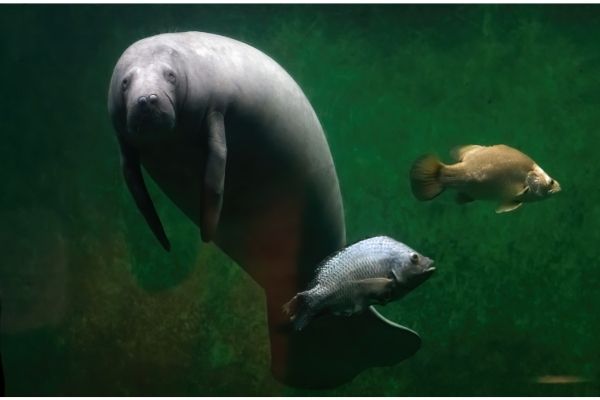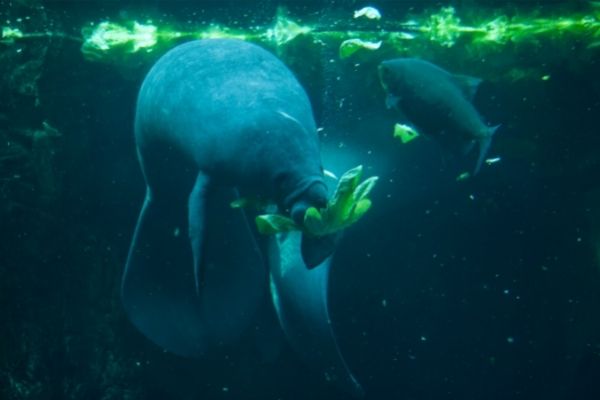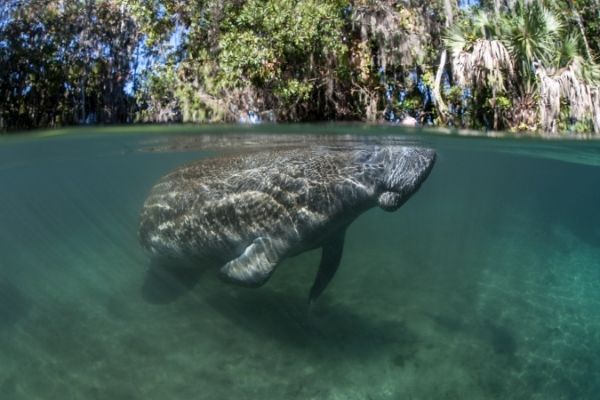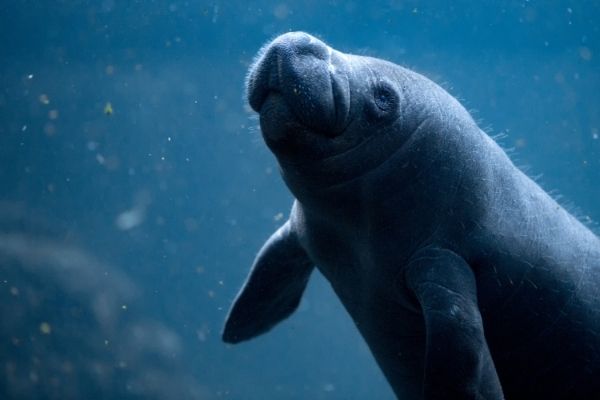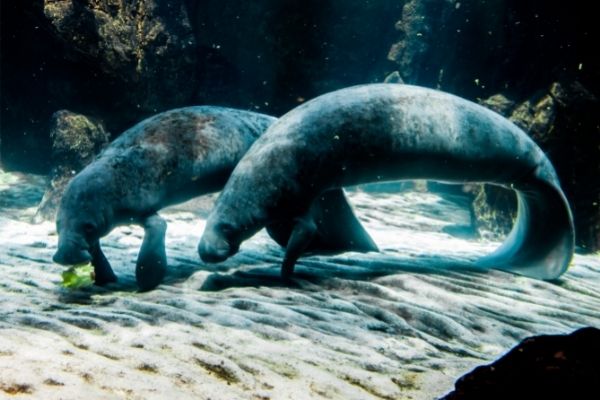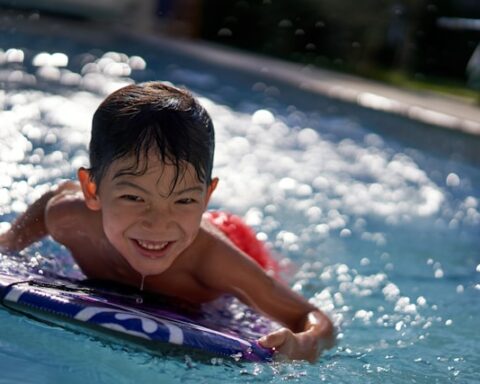Manatee is a very unique animal that is mostly found on the subtropical and tropical Atlantic coasts. It can be easily identified by its huge size and slow movement. We have listed down complete Manatee Facts for Kids that will help you in learning all about Manatees. You are going to learn about its scientific name & classification, evolution, appearance, physical features, physical abilities, diet, habitat, lifespan, reproduction, babies, behavior, adaptations, food chain, ecological role, endangerment, population, predators, and many other interesting facts about Manatees.
Manatee Facts For Kids
What Is A Manatee
- Manatees are huge, completely aquatic marine mammals.
- They are mostly herbivorous and also known as sea cows.
- They belong to the genus Trichechus, which has three accepted living species.
- Manatees have streamlined bodies that are well-adapted to the aquatic lifestyle.
- They inhabit the tropical and subtropical coastal and inland waters along the Atlantic ocean, the Caribbean, and western Africa.
- All three species of manatees are Vulnerable on the IUCN Red List.
Scientific Name Of Manatee
The scientific names of the three living manatee species are:
- Trichechus inunguis
- Trichechus manatus
- Trichechus senegalensis
Taxonomy Or Scientific Classification Of Manatee
The following is the scientific classification or taxonomy of manatees:
- Kingdom = Animalia
- Phylum = Chordata
- Sub-phylum = Vertebrata
- Class = Mammalia
- Order = Sirenia
- Family = Trichechidae
- Genus = Trichechus
- Species
- Trichechus inunguis
- Trichechus manatus
- Trichechus senegalensis
Species Of Manatees
There are three acknowledged species of manatees.
- Amazonian manatee (Trichechus inunguis) is found in the Amazon Basin.
- West Indian manatee (Trichechus manatus) is further divided into two subspecies; the Florida manatee (Trichechus manatus latirostris) is found along the coasts of Florida, and the Caribbean or Antillean manatee (Trichechus manatus manatus) that is found throughout the Caribbean.
- African manatee (Trichechus senegalensis) is found in the western regions of Africa.
Evolution Of Manatee
- The fossil records of the Sirenians (manatee ancestors) are believed to be about 50 million years old.
- Their modest diversity evolved during the Oligocene and Miocene, however, they declined due to the cooling of the climate, oceanographic changes, and the interference of humans.
- It is believed that manatees and elephants share a common ancestry.
What Does A Manatee Look Like
Appearance
- Manatees have streamlined heavy bodies ending in a flat paddle-shaped tail.
- They have no hind limbs, while their forelimbs are modified into paddle-like flippers.
- They have shorter snouts as compared to dugongs (their fellow Sirena).
- Their upper lip is large, prehensile, and flexible.
- They have small eyelids and their eyes close in a circular way.
- Manatees have a set of cheek teeth that are not well-differentiated into premolars and molars. Adult manatees also lack incisors and canines. Their teeth are continuously replaced throughout their life. At a time, they have only six teeth in each jaw.
- Female manatees have two teats, one located under each flipper.
- West Indian and African manatees have nails on their flippers. Amazonian manatees lack nails.
- Unlike other mammals, manatees have only six cervical vertebrae (neck vertebrae). Other mammals besides manatees with an unusual number of cervical vertebrae are two-toed and three-toed sloths.
Color
- Manatees have a grey skin color. However, it may appear brownish-grey.
- Amazonian manatees also have pink or white patches at the chest and belly.
- In some cases, algae grow on the skin of slow-moving manatees that change their color and make them seem more brown or green.
Physical Features
The physical features of all the manatee species are shown in the following table:
| S.No | Species | Length (meter) | Weight (kg) |
| 1 | Amazonian manatee | 0.76 to 2.55 (males)
0.71 to 2.66 (females) |
7.5 to 346.5 (males)
8.1 to 379.5 (females) |
| 2 | West Indian manatee | 2.7 to 3.5 (average) | 200 to 600 (average) |
| 3 | African manatee | Up to 4.5 | About 360 |
Physical Abilities
-
Speed
-
- Manatees generally swim at the speed of 5 to 8 km/h (3 to 5 mph).
- They are known to swim at the speed of 30 km/h (20 mph), but only for short bursts.
-
Jump
-
- Manatees are slow and can not jump. As jumping from the water needs some speed that a manatee can not attain.
-
Swim
-
- Manatees are marine mammals and spend their lives in water.
- So they are well-adapted to swim and are excellent swimmers.
What Do Manatees Eat
Diet
-
In Wild
-
- Manatees are primarily herbivorous and eat a wide variety of fresh-water and salt-water vegetations.
- They are also sometimes observed to eat foods other than vegetation. African manatees are known for eating clams, while Antillean manatees (subspecies of West Indian manatees) are known for eating fish from nets.
- The African manatees in Sierra Leone sometimes feed on the fields of planted rice and are considered pests.
- As the diet of manatees has high fiber and low nutrition, they consume a large amount of food and need to graze for up to seven hours daily.
- Manatees are hindgut fermenters like horses. It makes the digestion process possible and helps them to cope with a high level of cellulose in their diet.
- Manatees can survive without feeding for months because of their low metabolic rate. Amazonian manatees fast during the dry season when the water level is high and their access to vegetation is prevented. Speculation says that Amazonian manatees can fast for about seven months.
-
In Captivity
-
- In captivity, manatees are fed with lettuce along with a few other green plants, fruits (such as apples), and vegetables (carrots and sweet potatoes).
- Their diet is also supplemented with elephant vitamins.
List Of Food Items
- The following are some of the food items a manatee eat:
- Floating hyacinth
- Pickerelweed
- Water celery
- Hydrilla
- Alligator weed
- Musk grass
- Water lettuce
- Mangrove leaves
- Seagrass
- Manatee grass
- Turtle grass
- Shoal grass
- Sea clover
- Widgeon grass
- Marine algae
How Much Manatees Eat Per Day
- An adult manatee daily eats up to 10 to 15% of their whole body weight.
- Another source says that they daily eat about 4 to 9% of their whole body weight in wet vegetation. This amount is about 15 to 49 kg (32 to 108 lbs.) of food.
What Do Baby Manatee Eat
- Baby manatees exclusively consume mother milk for the first few weeks of their life.
- They then also start to nibble on plants along with feeding on the mother milk.
Where Do Manatees Live – Manatee Habitat
Natural Habitat
- The natural habitat of manatees is rivers, canals, bays, estuaries, and coastal regions rich in vegetation.
- They inhabit fresh, saline, and brackish waters and freely move between extremes.
- West Indian manatees are usually found in waterways connected to the coast with over 1 meter (3.25 feet) depth. They rarely venture into the deep waters of the ocean. They prefer to live in waters with temperatures above 21℃ (70℉). They can not tolerate prolonged exposure to waters with temperatures below 20℃ (68 ℉) because of their low metabolic rate. It can cause “cold stress syndrome” in them and can lead to death.
- The African manatees are found in coastal regions, lagoons, large rivers, and connected lakes. They prefer to live in waters with temperatures above 18 ℃ (64 ℉).
- The natural habitat of Amazonian manatees is freshwater. They are commonly found in floodplain lakes and channels in the river systems of white water. The temperature of the waters they inhabit ranges from 25 to 30 ℃ (77 to 86 ℉).
Biome
- Manatees are found in the aquatic biomes of marine and freshwaters.
- The biomes they inhabit include coastal waters, brackish waters, rivers and streams, lakes, and ponds.
Range
- All species of manatees inhabit the warm tropical and subtropical coastal and inland waters along the Atlantic ocean, the Caribbean, and western Africa.
- The habitat range of the West Indian manatees was once all over the tropical and subtropical waters of the western North and South Atlantic ocean and the Caribbean. However, their number declined greatly and they are now rarely seen in their range. The primary range of the Florida manatee subspecies is the coastal regions of Florida. However, it extends in the north as far as Massachusetts and in the west as far as Texas. The range of the Antillean subspecies is throughout the Caribbean, extending in the north as far as Mexico and in the south as far as Brazil.
- The habitat range of the African manatee is the coastal regions of western Africa, from Senegal to Angola.
- Amazonian manatee is the only manatee species restricted to freshwaters. It is found in the Amazon Basin. It is found mostly in Brazil and is very rare in Peru, Ecuador, and Columbia.
Countries List
- United States
- Mexico
- The Caribbean countries
- Brazil
- Ecuador
- Peru
- Columbia
- Senegal
- Angola
Manatee Lifespan
In Wild
- The average lifespan of manatees in the wild is 30 years.
- They live for a maximum age of about 50 years in the wild.
In Captivity
- In captivity, the average lifespan of Amazonian manatees is 12.5 years, while that of African and West Indian manatees is 28 years.
- The oldest captive individual was Snooty, at the South Florida Museum’s Parker Manatee Aquarium, who died at the age of 69 years.
Manatee Life Cycle
- The life cycle of a manatee starts when it is born after a gestation period of about 12 months.
- After birth, it depends on its mother for food and protection for up to two years and then becomes independent.
- When it becomes sexually mature, it starts breeding and producing its offspring.
- The average lifespan of manatees is about 30 years in the wild and 12.5 to 28 years in captivity.
Manatee Reproduction
- West Indian and African manatees reproduce throughout the year. While Amazonian manatee reproduces seasonally and most births occur between December and July.
- Female manatees reproduce after every two to five years. However, females who lost their calves are known to reproduce again in just one year.
- During the breeding season, many males follow a female for mating. The group of following males is known as a mating herd.
- The gestation period of manatees is about 12 months.
- Usually, only a single calf is born and twins are very rare.
- The calf is born underwater, either head or tail first.
- Just after birth, the mother helps the calf to rise to the surface for breath.
- Mother feeds the little one with her milk.
- The milk of manatees has 7% proteins, 13% fats, 20% solids, and about 60% water.
Manatee Baby
- A manatee baby is known as a calf.
- At birth, the calf of West Indian manatees weighs about 27 to 32 kg and measures 1.2 to 1.4 meters. While the calf of the Amazonian manatee measures approximately 30 inches.
- At birth, its skin has fetal folds that last for several weeks.
- The newborn becomes able to swim on its own about an hour after birth.
- Calf makes sounds soon after birth to communicate with its mother.
- The calf starts to nurse within a few hours after birth. It suckles from teats located under the pectoral flippers of the mother.
- After a few weeks of its birth, the calf then starts nibbling on vegetation.
- The calf is weaned at the age of about one year. However, it stays close to the mother for up to two years. At this time, it depends on the mother for food and protection. It also learns from the mother about feeding and resting sites, travel routes, and warm water accommodations.
- Female calves attain sexual maturity at the age of about 3 years, while males at the age of about 9 to 10 years.
Manatee Male Vs Female
- A male manatee is known as a “bull”, while a female manatee is known as a “cow”.
- Manatees are sexually dimorphic and females usually have larger body size and weight than males of the same age.
- Females are responsible for raising calves.
Behavior Of Manatees
- Manatees are primarily solitary animals. However, they sometimes gather in small transient groups for hours or days.
- They are non-territorial and non-aggressive creatures.
- They remain active during the day and night. They spend about 50% of their daytime sleeping. They sleep submerged and regularly surfacing for air at intervals shorter than 20 minutes. They spend the remaining time investigating objects and grazing in shallow water at the depth of 1 to 2 meters.
- Manatees are intelligent creatures. They can understand discrimination tasks and exhibit signs of complex associative learning. It is believed that their long-term memory is also good. Like dolphins and pinnipeds, manatees demonstrate task-learning and discrimination abilities in visual and acoustic studies.
- Florida manatees are known to migrate southward in the winter season. Amazonian manatees also migrate during the dry and rainy seasons, when fluctuation of the water level occurs in their habitat.
Habits
- Manatees walk along the bottom using their flippers to dig the roots and plants. They use their flippers to scoop vegetation towards their lips.
- They are curious creatures and often investigate objects like boats. Because of their curious nature, they mostly do not scare away in the presence of humans swimming with them.
Communication
- Manatees make a wide range of sounds to communicate, especially mothers and their calves. Adults communicate to remain in contact during sexual and play behaviors. Along with sight, sound, and touch, they also use taste and smell as a form of communication.
Manatee Adaptations
Manatees are well-adapted to the aquatic lifestyle and high-fiber food. The following are the major adaptation that helps them to survive:
Physical Or Structural Adaptations
-
Streamlined Bodies
-
- Manatees have streamlined bodies that are well-adapted for their aquatic lifestyle.
- Streamlined bodies help them to move easily through the water and faceless amount of resistance.
-
Flippers
-
- The forelimbs of manatees are modified into flippers.
- They use their flippers to propel water during swimming.
- They also use it to walk along the sea bottom while they dig for plants and roots.
- They also use their flippers to scoop vegetation towards their lips.
-
Prehensile Upper Lip
-
- Manatees have large, flexible, and prehensile upper lips.
- Their upper lip pad is split into independently moveable left and right sides.
- Their lips handle and tear plants through the use of seven muscles.
- The lips are also used along with flippers to move plants into the mouth.
-
Ridged Pads On The Mouth Roof
-
- Manatees have dense ridged pads at the roof of their mouth.
- As they do not have any front teeth, so the horny ridges and lower jaws are used to tear the ingested plant matter.
-
Sensory Hairs (Vibrissae) On The Upper Lip
-
- Manatees have sensory hairs and bristles on the upper lip.
- It helps them to discriminate between vegetations and to manipulate food plants.
-
Continuous Replacement Of Teeth
-
- The teeth of manatees are continuously replaced throughout their life.
- Their teeth have weak enamels that face abrasions from the ingested silica and sand.
- So when the anterior teeth of the row wear down, they are shed and the posterior teeth erupt at the back and slowly move forward like a conveyor belt to replace them.
Physiological Adaptations
-
Long Intestines
-
- As manatees eat aquatic vegetations, which are low in energy and proteins. So they eat a large amount of food to fulfill their dietary requirements.
- To handle such a large amount of cellulose-rich diet, manatees are adapted to have about 30 meters (100 feet) long intestines.
- They are also hindgut fermenters like horses, and symbiotic bacteria in their hindgut helps to digest cellulose.
-
Low Metabolic Rate
-
- Manatees have a very low metabolic rate.
- It makes it possible for them to survive on low-energy food and to tolerate long fasting periods.
-
Parallel Orientation Of The Lungs
-
- The orientation of the manatee’s lungs is parallel to the water surface.
- Their lungs also can control the volume of small air spaces.
- The bones of their ribs do not have marrow and are dense and heavy.
- All these characteristics allow them to maintain a horizontal orientation in the water anywhere; at the bottom and surface.
- Their lungs also can replenish about 90% of the air with each breath (humans replenish only about 10%). It allows them to remain submerged in the water for up to 20 minutes.
Manatee Food Chain
- Like most food chains of animals, the sun is also the overall source of energy in the food chain of manatees.
- Plants are producers and take energy from the sun and prepare their food itself through photosynthesis.
- Manatees are the primary consumers of the food, as they eat only vegetation as a major source of their diet.
Ecological Role Of Manatees
- Manatees play a vital ecological role in their ecosystem. They eat a huge amount of aquatic vegetation and prevent it from being obstructive.
- When they excrete the digested flora in their surrounding, it helps the nutrients to recycle.
- They also maintain the health of the seagrass bed. Their presence and flourishing indicate that the ecosystem they live in is healthy.
Population Of Manatees
- The exact population of the Amazonian and African manatee species and the Antillean manatee (subspecies of West Indian manatee) is unknown. However, the population trend of all the species has declined over the past hundred years.
- The population of Florida manatee (subspecies of West Indian manatee) has been estimated as 2,505 individuals in 2004. In 2005, their population was then estimated as 3,143 individuals.
Manatee Endangerment
- Manatees are not endangered. However, they are facing many threats to their survival.
Reasons
- The major reasons for the manatee’s death are human-related issues, such as human objects and the destruction of habitat. Natural reasons for their death include diseases, adverse temperatures, and predation of the young ones by crocodiles. The following are the major reasons that causing threat to the survival of the manatees:
- Ship Strikes cause serious injuries, disfigurement, and even death of manatees. As manatees are slow-moving and curious, they often inspect boats, ships, and large vessels that led to violent collisions.
- Red Tide is a large concentration of aquatic microorganisms. It is a common term used for algal blooms. These microorganisms produce toxins that affect the central nervous system of animals. In 1996, a red tide caused the death of 151 manatees. While in 2005, it resulted in 44 deaths.
- Other Human Activities, such as water control structures (floodgates and navigation locks, etc.) cause the isolation and even crushing of manatees. They are also sometimes entangled and killed in fishing gear. In Florida, people are allowed to swim with manatees that cause disturbance and harassment. The United States Fish and Wildlife Service reported that about 99 manatees die every year due to human activities.
Conservation Status
- The conservation status of all the three manatee species on the IUCN Red List as Vulnerable.
Manatee Predators
- Manatees have no natural predators.
- Killer whales (orcas), sharks, and alligators or crocodiles could be their predators. However, they are not found in the waters where manatees live, so this is very rare.
- Crocodiles sometimes prey on young manatees.
- Only humans are the biggest predators of manatees and hunt them for meat and skin.
Manatee Fun Facts
- Manatees are also called sea cows because of their grazing on the sea plants similar to cows on the land.
- They are closely related to elephants and hyraxes. Their common ancestor was a land mammal that lived about 50 million years ago.
- Manatees have smooth brains. The ratio of their brain size to body size is the lowest of all mammals.
- Manatees and sloths are the only mammals that do not have 7 neck vertebrae.
- The large size of manatees is not due to the high amount of fats in their bodies, but rather because of their large stomach and intestines.
- Manatees have 3 to 4 nails at the end of their flippers. Amazonian manatees do not have nails and their specific name inunguis is a Latin word, which means ‘nails or without nails’.
- Manatees are hindgut fermenters like horses and have very long intestines (about 30 meters long).
- They make several sounds underwater, including chirps, squeaks, and whistles. They seem to emit these sounds when they feel threatened or communicate with each other.
- Manatees have well-developed eyesight and can see and detect objects at a distance of ten meters.
- As manatees do not have many fats in their bodies, they are highly susceptible to cold.
- Manatees are intelligent and exhibit task-learning and discrimination abilities like dolphins and pinnipeds.
FAQs:
Can A Manatee Kill You?
- No, a manatee can not kill you.
Are Manatees Dangerous?
- No, manatees are not dangerous.
Are Manatees Friendly?
- Yes, manatees are friendly.
- They are gentle and peaceful creatures. In search of warmth, they often tend to flock towards human activity.
Why Is It Not Ok To Swim With Manatees?
- Manatees are wild animals and become disturbed when someone swims along with them.
- They should be left alone because they are sometimes scared away from the food when people yell and splash while swimming along with them.
What Eats A Manatee?
- Sharks, killer whales, and crocodiles are the possible predators of manatees. However, they do not inhabit the same waters.
- Humans are the biggest hunters of manatees and eat their meat.
Do Sharks Attack Manatees?
- Yes, sharks will attack manatees if they find them.
- However, manatees and sharks do not inhabit the same waters, so the possibility of their encounter is very rare.
What Does Manatee Taste Like?
- The meat of the manatee tastes like beef and pork.
Why Are Manatees So Fat?
- Manatees have a very little amount of body fat.
- However, they look fat because of their exceptionally large stomach and intestines.
Are Manatees Smart?
- Yes, manatees are smart. Their task-learning and discrimination abilities are similar to that of dolphins and pinnipeds.
Are Manatees Blind?
- No, manatees are not blind.
- They have good eyesight and can see and detect things at a distance of tens of meters.
- Research says that they also recognize blue and green light pigments.
Article Short Summary
- Manatees are gentle and peaceful marine mammals of huge size.
- There are three species of manatees; the West Indian manatee, the Amazonian manatee, and the African manatee.
- They are found in the tropical and subtropical waters along the east coast of North America, the Amazon River, and the west coast of Africa.
- Their body is well-adapted to live in marine habitats. They have a streamlined body with a paddle-like tail. Their forelimbs are modified into flippers.
- Manatees are herbivores and eat a wide variety of marine vegetation. They are hindgut fermenters like horses and have extremely long (about 30 meters) intestines.
- They reproduce after every two to five years and usually have a single calf.
- Manatees are primarily solitary animals and spend most of their time grazing and sleeping.
- Manatees are intelligent and their task-learning and discrimination abilities are similar to that of dolphins and pinnipeds.


